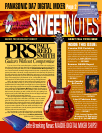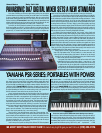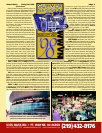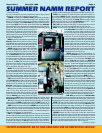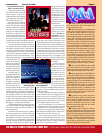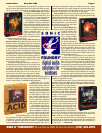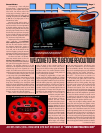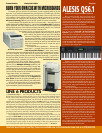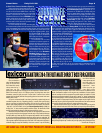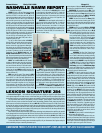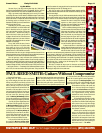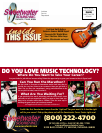
Sweet Notes Early Fall 1998 Page 2
WE ACCEPT EVERY MAJOR CREDIT CARD!
We make it easy to get the gear you need! Call us at
(219) 432-8176
PANASONIC DA7 DIGITAL MIXER SETS A NEW STANDARD
You've been considering one of the new digital mixing consoles, but you might be
concerned about the steep learning curve. When you read the feature list on these babies,
it's easy to assume they're going to be formidable machines. Relax. You can have digital
power without shutting your studio down for a few weeks to learn an entirely new user
interface. Introducing the Panasonic DA7, a board with all the really important bells and
whistles (and truly impressive specs!), but one that you'll feel right at home with. Oh, and
a price that you'll feel pretty good about, too: Under $5,000 — and that’s list!
For those of you who may have been vacationing in some remote area of the Amazon
for the last six months or so, the DA7 is a 32-input, eight-bus, six Aux mixer that offers true
24-bit I/O capability (and let’s face it, the future is 24-bit, so you might as well get with the
program now), 5.1 surround sound mixing mode, extensive dynamic and snapshot auto-
mation and one function/one step screen layer operation, to name just a few features.
Internally, the DA7 reflects Ramsa's expertise in digital consoles (Ramsa's DX-1000 digi-
tal console has been critically acclaimed in Japan for years, though it has been unavailable in
the US) and Panasonic's powerful influence in digital audio recording environments — Ramsa
is the pro audio division of Panasonic, just in case you were wondering why there are two
names on the board. Ergonomically, the console has the look and comfortable feel of a famil-
iar analog friend, and houses an “LED Farm” display: A series of LEDs providing a quick look
at the routing status, automation modes, Channel On/Off status, EQ On/Off, Dynamics On/Off,
Panning In/Out, and Aux Send On/Off. Additionally, quick access to the console's current con-
figuration is accessible via a large screen graphic display, designed to eliminate having to dig
deep into layers of screens to view routing configuration information.
As a matter of fact, Ramsa engineers took the “time is money” reality of studio and
broadcast environments seriously when designing the graphics display routing feature. The
displays of channel settings and parameters are all quickly accessible via a quick touch of the
assignable control buttons. The type or amount of data to be displayed on the screen can be
user defined, while certain indicators, such as a SMPTE Time Code readout, are present on all
screens. All mix, processing, routing, and surround sound parameters are accessible via the
graphics display. Built-in parametric EQ and dynamic controllers are assignable on all inputs
and Aux Returns. Via the unit's MIDI ports, a variety of external automation operations are
possible, including control of external effects and other MIDI compatible instruments. In ad-
dition, up to 50 each of EQ, Dynamics and Channel Status settings can be stored, as well as
50 Global settings of the entire console for instant recall.
Industry experts are already singing the praises of the Panasonic DA7. In the July
issue of
EQ
, Craig Anderton wrote, “The (user) interface is, in a word, marvelous. I was
able to get quite far without looking at the manual. I hesitate to say that, though,
because you can’t use the DA7 to its full advantage unless you do read the manual
— there are many shortcuts and nifty little features.”
Put together all the features and user-friendly interface with the DA7's rather
breathtakingly low list price, and you have to admit — I mean
have to!
— that
this is one of the most impressive price-to-performance items to come along
in quite some time. Yes, you can spend more on a digital mixer, but most of us
would rather pay less and get all the functionality and sonic performance we
need (personally, I don’t need that integrated digital bun warmer) in one pack-
age that’s ready to plug in and use to make great music.
YAMAHA PSR-SERIES: PORTABLES WITH POWER
There was a time, not long ago, when portable keyboards were rated not by
their sound, but by their cheese factor: Little plastic machines making little plastic
bossa nova rhythms. Man, have times changed. From first hand experience, I can
tell you that today’s portables have very little in common with their ancestors. See,
I bought my father a Yamaha PSR530 last Christmas. I bought it because he had to
give up his prized Kimball piano when he moved into his retirement community and
he wanted something he could use to continue writing music in his spare time (I
think his retirement is more active than my so-called “normal” life).
He and I were both amazed when we heard the quality of the sound coming out
of the onboard speakers. But what was even more startling was the complexity and
sophistication of the built-in accompaniment. My first thought was: I gotta get me
one of these things. As a late night “sketchpad,” I wouldn’t even need to turn on
the equipment in my studio to lay down some tracks. That’s because the integral
multi-track sequencer can store everything until I have a chance to either write
out the parts or sit down and record the “real thing” in my studio. For me, there’s
nothing worse than losing an inspiration because I haven’t got a tape cued up.
And then I thought: “Wow! I could even take this thing with me to the
beach or up to the mountains.” Duh! Yamaha has been telling us this for years.
Guess I wasn’t paying attention (hey, I was real busy, okay?).
Take it from me, every keyboard player needs one of these machines. You
won’t believe how good they sound or how much attention Yamaha paid to the
sheer musicality of the accompaniment styles. Yes, there’s still a polka or two lurk-
ing in there, but there’s more than enough rock, jazz, country and Latin grooves to
keep anyone tapping their toe — these are accompaniment styles that are truly so
good they can actually
inspire your creativity!
I won’t take up a lot of space here listing all the different PSR-Series keyboards
that Yamaha makes — it would take up two pages anyway. Log on to Sweetwater’s
Web site and you can download all the information you need on these amazingly
versatile and surprisingly affordable instruments (prices start at just $149.95). While
you’re there (in case you still don’t believe me when I say these things are amazing),
check out the Yamaha PSR8000 with its Virtual Arrangement function (intros/end-
ings, multiple fills, bridge/chorus/verse arrangements), Vocal Harmony feature (build
your own backup singers) and Gender Function/Pitch Correction (shift the pitch of
your voice up or down while retaining human voice quality or just adjust the pitch of
your voice to match the key of the music). This is heavy duty musical firepower, folks.
Now if you don’t happen to have Net access at the moment, feel free to call your
Sweetwater Sales Engineer for all the specifics on these great instruments, plus your
very special low Sweetwater pricing. You’ll find it’s, well . . . inspirational!
— J.M.
The do-it-all, take it anywhere PSR630 from Yamaha: Nothing short of amazing!



